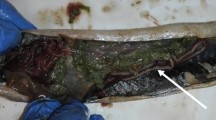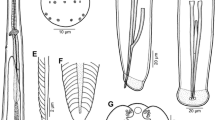Abstract
Purpose
Philometrid nematodes (Philometridae) represent a group of more than 200 species parasitic in the body cavity and various body tissues of fishes. Due to morphological and biological peculiarities, the majority of them are known only by their large females. Generally, the fauna of these parasites remains little known.
Methods
Occasional helminthological examinations of three species of marine fishes in Japan revealed two new and one insufficiently known species of these tissue-dwelling parasites. These were studied with the use of light and scanning electron microscopy.
Results
All three nematode species are described. Philometra ostorhinchi sp. nov. (males and females) from the ovary of Ostorhinchus semilineatus (Temminck et Schlegel) (Apogonidae, Perciformes) is characterized mainly by the lengths and structure of spicules and the gubernaculum (spicules 108–120 µm long, length of the gubernaculum 78–87 µm); it is the only species of philometrids parasitic in a fish belonging to the Apogonidae. The gravid females of Philometra tenuis sp. nov. (only females available) from the head subcutaneous tissues of Conger myriaster (Brevoort) (Congridae, Anguilliformes) differ from congeners mainly in an unusual shape of the anterior oesophageal bulb. Some new data on the morphology of an insufficiently known species Philometroides seriolae (Ishii, 1931), collected from the body musculature of Seriola quinqueradiata Temminck et Schlegel (Carangidae, Perciformes), are provided; the number and arrangement of cephalic papillae in subgravid females of P. seriolae were found to be similar to those in females of the majority of other philometrid species.
Conclusions
The present study extends the knowledge of the species composition of philometrids parasitizing marine fishes and of the morphology of P. seriolae, the type species of Philometroides Yamaguti, 1935.






Similar content being viewed by others
References
Nagasawa K (2008) Synopsis of nematodes of the superfamilies Dracunculoidea and Anguillicoloidea parasitic in fishes and amphibians of Japan (1916–2008). Bull Biogeogr Soc Japan 63:111–124 (In Japanese, Engl summary)
Moravec F, Nagasawa K, Nitta M, Tawa A (2019) New records of philometrids (Nematoda: Philometridae) from marine fishes off Japan, including description of Philometra kidakoi sp. n. and Congerinema japonicum gen. et sp. n. Folia Parasitol (in press)
Froese R, Pauly D (eds) (2019) FishBase. World Wide Web electronic publication. http://www.fishbase.org, version 03/2019
Moravec F, de Buron I (2013) A synthesis of our current knowledge of philometrid nematodes, a group of increasingly important fish parasites. Folia Parasitol 60:81–101. https://doi.org/10.14411/fp.2013.010
Moravec F, Bakenhaster M, Fajer-Ávila EJ (2014) Three new gonad-infecting species of Philometra (Nematoda: Philometridae) parasitic in Lutjanus spp. (Lutjanidae) in the northern Gulf of Mexico off Florida, USA. Folia Parasitol 61:355–369. https://doi.org/10.14411/fp.2014.041
Moravec F, Chaabane A, Neifar L, Gey D, Justine J-L (2016) Descriptions of Philometra aenei n. sp. and P. tunisiensis n. sp. (Nematoda: Philometridae) from Epinephelus spp. off Tunisia confirm a high degree of host specificity of gonad-infecting species of Philometra Costa, 1845 in groupers (Serranidae). Syst Parasitol 93:115–128. https://doi.org/10.1007/s11230-015-9610-z
Yamaguti S (1935) Studies on the helminth fauna of Japan. Part 9. Nematodes of fishes, 1. Jap J Zool 6:337–386
Yamaguti S (1941) Studies on the helminth fauna of Japan. Part 33. Nematodes of fishes, II. Jap J Zool 9:343–395
Moravec F, Nagasawa K, Ogawa K (1998) Observations on five species of philometrid nematodes from marine fishes in Japan. Syst Parasitol 40:67–80. https://doi.org/10.1023/A:1005976012723
Moravec F, Ogawa K, Suzuki M, Miyazaki K, Donai H (2002) On two species of Philometra (Nematoda, Philometridae) from the serranid fish Epinephelus septemfasciatus. Acta Parasitol 47:34–40
Quiazon KMA, Yoshinaga T, Ogawa K (2008) Taxonomical study into two new species of Philometra (Nematoda: Philometridae) previously identified as Philometra lateolabracis (Yamaguti, 1935). Folia Parasitol 55:29–41. https://doi.org/10.14411/fp.2008.005
Quiazon KMA, Yoshinaga T, Ogawa K (2008) Philometra sawara sp. n. and a redescription of Philometra nemipteri Luo, 2001 (Nematoda: Philometridae): a morphological and molecular approach. Folia Parasitol 55:277–290. https://doi.org/10.14411/fp.2008.036
Molin R (1859) Abhandlugen und Mittheilungen. Sitzungsber Akad Wiss Wien 38:7–38
Rasheed S (1963) A revision of the genus Philometra Costa, 1845. J Helminthol 37:89–130
Moravec F (2006) Dracunculoid and anguillicoloid nematodes parasitic in vertebrates. Academia, Prague
Quiazon KMA, Yoshinaga T, Ogawa K (2010) Taxonomical note on the redescription of Philometroides seriolae (Ishii, 1931) infecting Japanese amberjack (Seriola quinqueradiata Temminck et Schlegel, 1845) in Japan. J Trop Biol 8:29–34
Kuroda T, Murayama T, Imai J, Horii Y, Nawa Y (1991) The first record of Philometroides sp. vomited from a man in Japan. Jap J Parasitol 40:599–603
Ishii S (1931) Parasites of fishes of Japan. Biology. Iwanami Publ Comp, Tokyo 18:179–207 (In Japanese)
Nakajima K, Egusa S (1969) Philometroides seriolae (Ishii, 1931) Yamaguti, 1935, a large nematode infecting farmed yellowtail. Fish Pathol 3:115–117 (In Japanese)
Nakajima K, Egusa S, Nakajima H (1970) Reproductive emergence of Philometroides seriolae from the host. Fish Pathol 4:83–86 (In Japanese, Engl summary)
Acknowledgements
We thank Dr. Gen Kume, Kagoshima University, for providing Philometra ostorhinchi specimens. Thanks are also due to the Laboratory of Electron Microscopy, Institute of Parasitology, Biology Centre CAS, institution supported by the MEYS CR (LM2015062 Czech-BioImaging) for their support with obtaining scientific data presented in this paper, and to Blanka Škoríková of the same Institute for help with illustrations.
Funding
This study was partly supported by the institutional support of the Institute of Parasitology, BC AS CR, 585110/9500.
Author information
Authors and Affiliations
Corresponding author
Ethics declarations
Conflict of interest
The authors declare that they have no conflict of interest.
Ethical approval
All applicable institutional, national and international guidelines for the care and use of animals were followed.
Additional information
Publisher's Note
Springer Nature remains neutral with regard to jurisdictional claims in published maps and institutional affiliations.
Rights and permissions
About this article
Cite this article
Moravec, F., Ogawa, K. Description of Two New Species of Philometra Costa, 1845 (Nematoda: Philometridae) from Marine Fishes off Japan, with Notes on Philometroides seriolae (Yamaguti, 1935). Acta Parasit. 64, 829–838 (2019). https://doi.org/10.2478/s11686-019-00107-y
Received:
Accepted:
Published:
Issue Date:
DOI: https://doi.org/10.2478/s11686-019-00107-y




